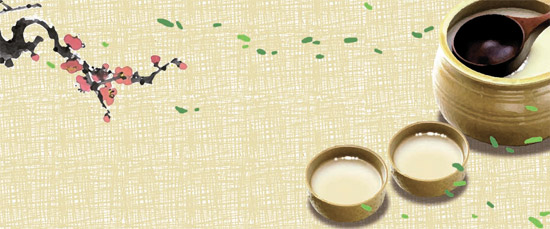Which liquor best represents Korea?

However, in modern society, alcohol can be a symbol of culture and a popular export item that defines a country’s image. European countries like France and other New World countries such as Australia, Chile and Argentina make money by exporting wines and create a graceful image at the same time. Germany and the Czech Republic are known for their beers. A Czech joke goes, an award-winning German beer was sent to a Czech beer-testing center, and it returned a report, “Your horse is in good health.” They claim even the best beer in another country is horse piss compared to Czech beer. The joke illustrates that alcoholic beverages can be linked to national identity and pride.
In Asia, China’s baijiu and Japan’s sake are well-known. Japan’s sake industry has imitated the Western wine industry, creating unique bottle and label designs and aggressive marketing campaigns with diverse tasting events and distillery tours. Japanese embassies worldwide are spreading the culture by offering sake and sushi to their guests.
India is emerging as an economic powerhouse, but it lacks notable traditional alcoholic beverages - possibly due to its high temperatures - while Indian food is popular internationally. Korea wants to globalize Korean cuisine but is struggling to find alcohol to create synergy. The rice wine makgeolli is too filling, and distilled soju lacks variety.
Poet Park Mok-wol wrote a poem with lyrics like, “Evening glow over villages brewing alcohol.” But the traditional brewing and distilling culture was lost during the Japanese occupation era.
Kang Hyoung-kee, a public administration professor at Chungbuk National University, and an expert in local autonomous administration, says that alcohol is a culture, a high-tech food and a product with high-added value. Grapes and berries bring three times more income as juice and six times more as alcohol, compared to when they’re used as fresh fruits.
Kang emphasized that we need to work on developing alcoholic beverages that can represent the country in order to vitalize our local economy and enhance our national image. He cited the example of Tokachi wine from Ikedamachi, a farming village in Tokachi County in Hokkaido, Japan.
The small village, with a population of 7,000, suffered from an earthquake in 1952 and poor harvests two years in a row. Then-village chief Ganeyasu Marutani, now 94, got an idea from local grapes and founded a local winery. After some trial and error, including cold weather completely freezing the grape vines, he successfully developed marketable wine in the 1970s.
In 1973, the village began a steak-and-wine festival, which celebrates its 40th anniversary this year. The wine-related profit is nearly 2 billion yen ($20.2 million). Now, Tokachi wine is known for its quality and is served to foreign heads of state.
Whether it’s wine or traditional liquor, we need to develop Korea’s alcoholic beverages. Just in time, President Park appointed Lee Dong-phil as the Minister of Agriculture, Food and Rural Affairs. Lee is known for his expertise in traditional liquor.
*The author is an editorial writer of the JoongAng Ilbo.
by Chae In-taek
최근 청와대와 정치권 행사에서 ‘노알코올 문화’가 대세라는 기사가 나왔다. 박근혜 대통령이 술을 입에 대지 않으니 각종 모임에서 자연스럽게 사라지고 있다는 내용이다. 하지만 현대사회에서 술은 나라 이미지를 좌우하는 문화 상징이자 수출 효자상품이다. 프랑스를 비롯한 유럽 국가들과 호주·칠레·아르헨티나 등 신대륙 국가는 포도주로 돈도 벌고 우아한 이미지도 얻는다. 독일·체코는 맥주로 유명하다. 품평회에서 우승한 독일 맥주를 체코 맥주시험장에 보냈더니 ‘당신의 말은 건강합니다’라는 통보가 왔다는 체코 농담이 있다. 딴 나라 최고의 맥주도 우리 것과 비교하면 말 오줌에 지나지 않는다는 뜻이다. 술이 국민 정체성과 국가 자부심과도 연결될 수 있음을 보여준다. 아시아에선 중국 바이주(白酒)와 사케(酒)로 불리는 일본 청주가 있다. 사케 업계는 와인산업을 벤치마킹해 개성 있는 병·라벨 디자인을 내놓고 시음회·양조장 초청 등 공세적 마케팅 활동을 벌인다. 해외 주재 일본 대사관 행사에선 사케와 초밥으로 문화외교 활동이 활발하다. 하지만 경제대국으로 부상하는 인도는 자국 음식이 인기지만 내놓을 만한 술이 없어 애태운다. 한국은 한식 세계화를 하려는데 시너지를 낼 술이 마땅하지 않다. 막걸리는 배가 부르고 증류식 소주는 구색이 다양하지 않다. 박목월이 ‘술 익는 마을마다 타는 저녁놀’이라고 노래했던 전통 가양주 문화는 일제시대를 거치면서 거의 사라졌다. 지방자치 전문가인 충북대 강형기(행정학) 교수는 “술은 문화이고 최첨단 식품이자 고부가 농산물이다”라며 “포도·복분자 생과일을 파는 것보다 주스로 가공하면 3배, 술을 담그면 6배의 소득을 올릴 수 있다”고 지적했다. 강 교수는 “지역경제에 활기를 불어넣고 국가 이미지를 높이기 위해 이젠 나라를 대표할 우리 술을 개발해야 한다”고 말했다. 강 교수는 일본 홋카이도(北海道) 도카치(十勝)군의 농촌마을 이케다마치(池田町)에서 나오는 도카치 와인을 예로 들었다. 인구 7000여 명의 이 마을은 1952년 지진과 2년 연속 흉작을 겪었다. 가난에서 벗어나려고 당시 정장(동장·이장 격)이던 마루타니 가네야스(丸谷金保·94)는 주변 산포도에서 착안해 마을 직영 와인회사를 차렸다. 숱한 시행착오 끝에 70년대에 들어서야 상품화에 성공했다. 73년엔 스테이크와 결합한 와인 축제를 시작해 올해로 40주년을 맞는다. 마을의 포도주 관련 수익은 매년 20억 엔에 이른다. 외국 정상 앞에 내놔도 손색이 없는 품질이다. 한국도 이젠 포도주든, 특산주든 우리만의 나라 술을 개발해야 한다. 마침 박 대통령이 발탁한 이동필 농림축산식품부 장관은 내로라하는 전통주 전문가다. 채인택 논설위원










with the Korea JoongAng Daily
To write comments, please log in to one of the accounts.
Standards Board Policy (0/250자)